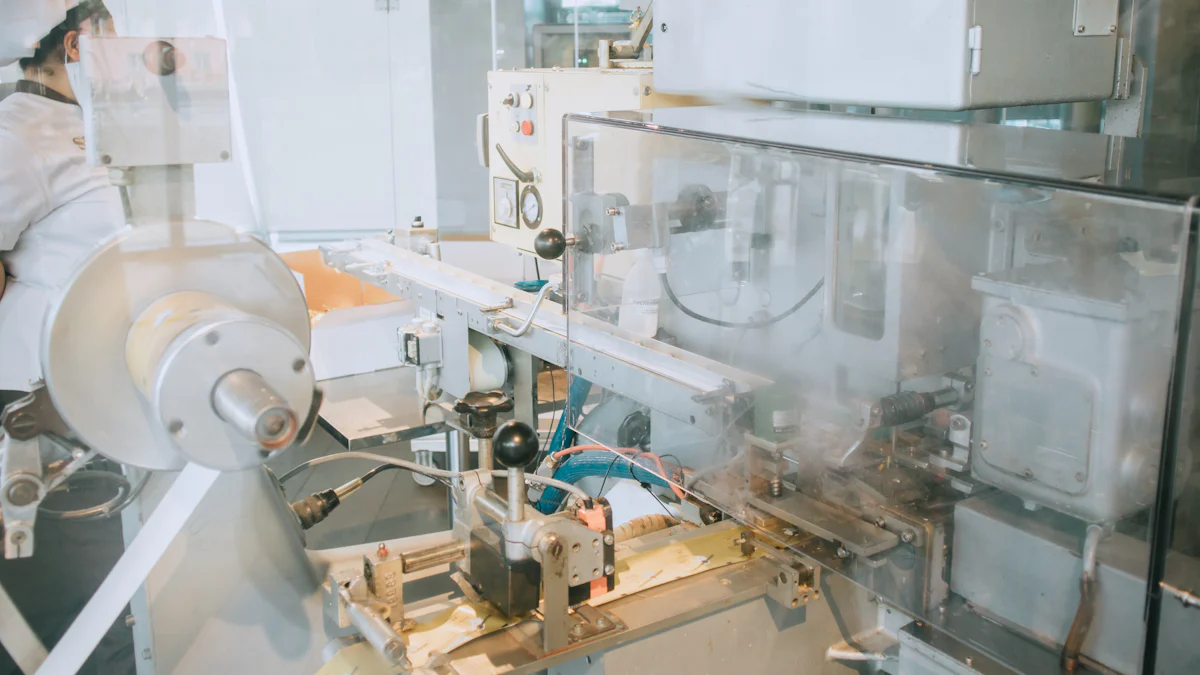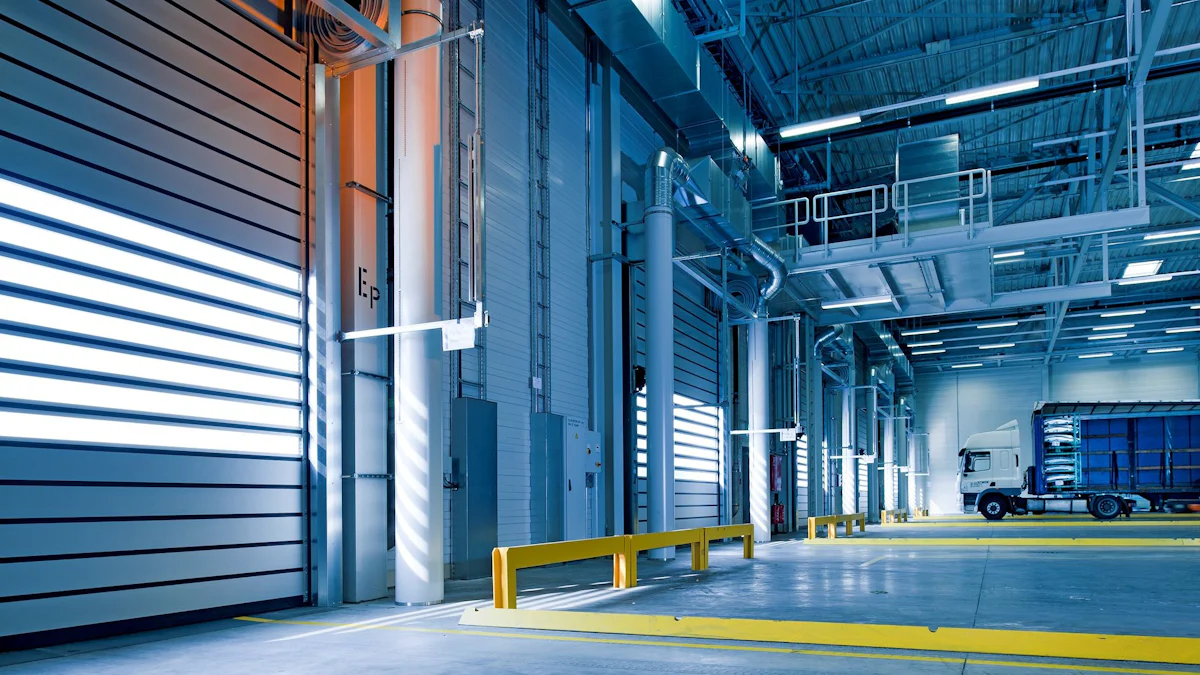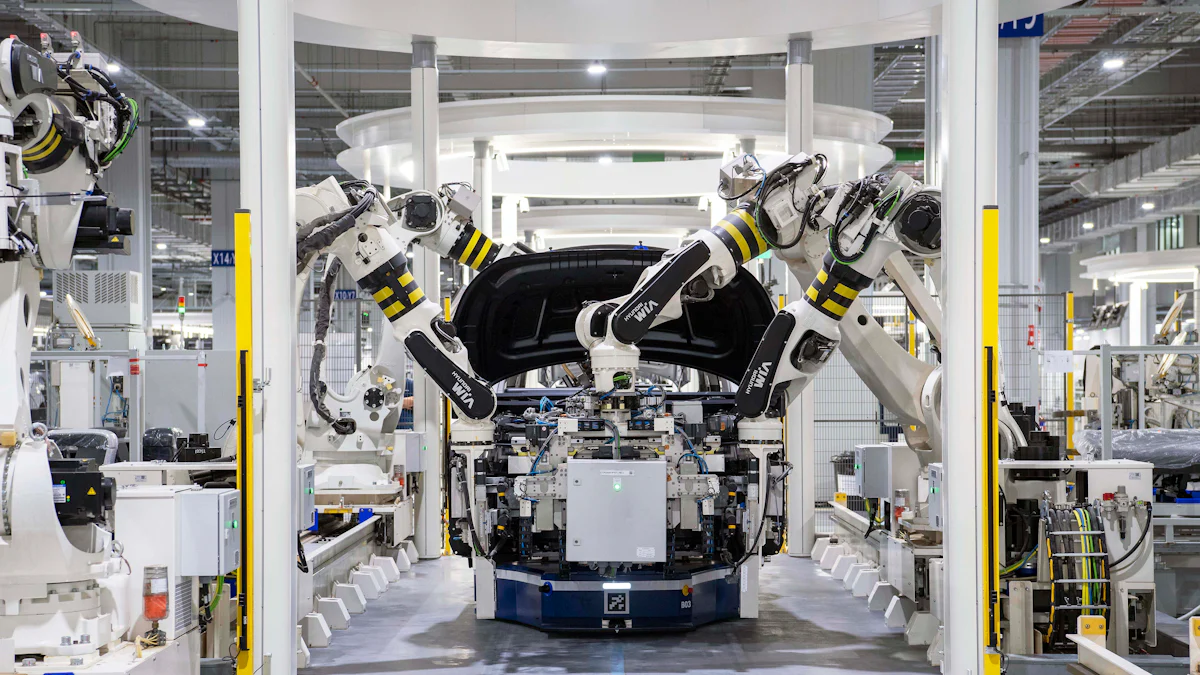Smart Spiral Freezers Driving Efficiency and Innovation

Spiral freezers play a vital role in modern food processing by rapidly freezing products while preserving their quality. Their unique design allows for continuous freezing, which increases productivity and ensures consistent results. Recent advancements in technology have further enhanced their efficiency. Features like artificial intelligence optimize freezing by monitoring and adjusting parameters in real time. IoT integration enables operators to analyze data and improve operations. Innovations such as high-velocity cold air circulation and improved insulation materials reduce energy consumption while maintaining uniform freezing. These developments make spiral freezers indispensable for producing high-quality frozen food efficiently.
Understanding Spiral Freezers
What Is a Spiral Freezer?
A spiral freezer is a specialized freezing system designed to rapidly freeze food products while maintaining their quality. Unlike traditional freezers, it uses a helical conveyor belt to move items through a freezing chamber. This design maximizes freezing capacity within a compact footprint, making it ideal for high-throughput production. Spiral freezers employ a 360-degree air freezing technique, which ensures even cooling across the product's surface. This method prevents ice crystal formation, preserving the texture and flavor of frozen food. Adjustable belt speeds allow operators to control the freezing duration, ensuring optimal results for various food types.
Characteristic | Description |
|---|---|
Conveyor System | Moves products through a helical pathway for continuous freezing. |
Freezing Capacity | Maximizes freezing capacity within a compact footprint, enabling high-throughput production. |
Quality Maintenance | Uses 360-degree air freezing to maintain texture and prevent ice crystal formation. |
How Spiral Freezers Work
Continuous Freezing Process
The freezing process in a spiral freezer ensures consistent product quality by maintaining moisture, texture, and freshness. It involves precise temperature control, efficient airflow, and advanced heat exchange mechanisms. Spiral freezers can reach temperatures as low as -100°C, enabling rapid freezing. This capability is crucial for preserving the integrity of frozen food, especially protein-rich items like poultry and seafood. The conveyor system, equipped with a transmission motor and mesh belt, moves products steadily through the freezing chamber. This continuous operation enhances productivity and reduces downtime.
Space-Saving Vertical Design
Spiral freezers feature a vertical design that optimizes space utilization. The helical conveyor belt stacks multiple tiers within a compact structure, allowing facilities to maximize production capacity without requiring large floor space. This design is particularly beneficial for food processing plants with limited room. The vertical layout also improves airflow distribution, ensuring uniform freezing across all product layers. By combining efficiency with a small footprint, spiral freezers meet the demands of modern food processing operations.
Applications in Food Processing
Commonly Frozen Products
Spiral freezers handle a wide range of food products, showcasing their application versatility. They are commonly used for freezing poultry, meat, seafood, fruits, vegetables, bakery items, and ready meals. Protein-rich foods like chicken breasts and fish fillets retain their moisture and texture during the freezing process. Fruits and vegetables maintain their color, taste, and nutritional value. Bakery products such as bread and pastries benefit from consistent freezing, preserving their freshness and texture. Ready meals like lasagna or stir-fry mixes also maintain their integrity, making spiral freezers indispensable in the frozen food industry.
Ensuring Food Quality and Safety
Spiral freezers play a critical role in maintaining food quality and safety. Rapid and uniform freezing preserves the texture, flavor, and nutritional value of food products. The controlled freezing environment minimizes microbial growth and spoilage risks. Additionally, the design of spiral freezers limits ice buildup, simplifying cleaning and ensuring compliance with food safety standards. These features make spiral freezers a reliable choice for producing high-quality frozen food while adhering to strict safety regulations.
Innovations in Spiral Freezer Technology

AI and Automation in Spiral Freezers
Predictive Maintenance
Artificial intelligence has revolutionized the functionality of spiral freezers by enabling predictive maintenance. AI algorithms analyze operational data to identify potential issues before they escalate. This proactive approach minimizes downtime and reduces repair costs. For example, AI can detect irregularities in belt movement or temperature fluctuations, allowing technicians to address problems promptly. By predicting maintenance needs, spiral freezers operate more efficiently and maintain consistent performance over time.
Real-Time Monitoring
Real-time monitoring systems enhance the operational efficiency of spiral freezers. IoT-enabled devices collect and analyze data continuously, ensuring optimal freezing conditions. Advanced sensors and control systems adjust parameters like temperature and airflow to maintain product quality. These systems also help food processors meet Industry 4.0 standards by automating processes and reducing manual intervention. Real-time monitoring ensures uniform freezing, minimizes waste, and supports intelligent freezing solutions.
Energy-Efficient Spiral Freezers
Advanced Insulation Materials
Energy-efficient models of spiral freezers incorporate advanced insulation materials to reduce heat transfer. These materials maintain low temperatures within the freezing chamber, minimizing energy consumption. Improved insulation also enhances the performance of advanced refrigeration systems, ensuring consistent cooling. By reducing energy loss, these innovations contribute to sustainable food processing and lower operational costs.
Low-Energy Refrigeration Systems
Low-energy refrigeration systems in spiral freezers optimize energy use while preserving food quality. Features like variable-speed fans and intelligent controls adjust cooling intensity based on product requirements. This approach reduces energy waste and operational costs. Additionally, faster freezing times achieved through these systems prevent spoilage, ensuring better food preservation. The integration of energy-saving technologies makes spiral freezers an eco-friendly choice for modern food processors.
Feature | Impact on Operational Costs |
|---|---|
Advanced Insulation | Minimizes heat transfer, reducing energy load. |
Efficient Airflow | Ensures optimal cooling with minimal energy waste. |
Continuous Freezing Process | Reduces product spoilage, lowering waste costs. |
Modular and Scalable Designs
Customizable Configurations
Customization options in spiral freezers address diverse food processing needs. Adjustable belt speeds and temperature settings allow operators to tailor freezing processes for specific products. For instance, pre-freezing, chilling, or deep-freezing modes can be selected based on requirements. Customization also extends to size and shape adjustments, optimizing workflow and maintaining product quality. These features make spiral freezers versatile and adaptable to various production environments.
Customization Feature | Benefit |
|---|---|
Size adjustments | Optimizes workflow and efficiency |
Shape adjustments | Maintains product freshness and quality |
Refrigeration methods | Tailors freezing process to specific needs |
Easy Maintenance and Upgrades
Modular designs simplify maintenance and upgrades in spiral freezers. Components can be replaced or upgraded without disrupting operations, ensuring minimal downtime. Compact footprints and scalable configurations cater to small and medium-sized facilities, enabling them to expand production capacity as needed. These designs also support sustainable practices by reducing waste and improving energy efficiency. Manufacturers benefit from streamlined operations and enhanced profitability.
Enhanced Hygiene and Safety Features
Automated Cleaning Systems
Automated cleaning systems in spiral freezers simplify maintenance while ensuring high hygiene standards. These systems, often equipped with Clean in Place (CIP) technology, provide systematic cleaning processes that reduce human error and contamination risks. CIP technology uses automated cycles to clean internal components without disassembling the equipment. This feature minimizes downtime and ensures thorough sanitation, which is critical for food processing facilities.
Modern spiral freezers also include easy-to-clean components and sanitary construction materials. These features prevent dirt accumulation and simplify cleaning procedures. Automated cleaning cycles further enhance efficiency by maintaining cleanliness consistently. For example, these systems can remove residue and microbial buildup from hard-to-reach areas, ensuring compliance with strict hygiene requirements. By integrating advanced cleaning technologies, spiral freezers uphold health and safety standards while protecting consumer health.
Compliance with Food Safety Standards
Spiral freezers are designed to meet stringent food safety regulations set by global authorities. Features like spacious access for cleaning and maintenance, along with automated cleaning systems, help facilities adhere to these standards. The design minimizes dirt traps and includes emergency stop buttons and accessible exits for worker safety. Regular inspection and maintenance ensure all components remain in good condition, preventing accidents and contamination.
Proper lockout/tagout procedures isolate the freezer from electrical power during maintenance, reducing hazards. Personal protective equipment (PPE) further safeguards workers during operation. These measures, combined with automated cleaning systems, ensure food safety enhancements in processing environments. By maintaining a clean and safe freezing environment, spiral freezers protect both workers and consumers while meeting regulatory requirements.
Tip: Facilities should prioritize regular maintenance and inspection to ensure the long-term safety and efficiency of spiral freezers.
Benefits of Smart Spiral Freezers

Boosting Efficiency and Productivity
Faster Freezing Times
Smart spiral freezers significantly reduce freezing times, ensuring rapid processing of high-value frozen foods. Their advanced systems utilize high-velocity cold air circulation, which accelerates the freezing process. This rapid freezing capability preserves the texture, taste, and nutritional value of food products. By maintaining consistent temperatures throughout the freezing chamber, these freezers ensure uniform results, even for large batches. Faster freezing times not only improve throughput but also enhance the overall efficiency of food processing operations.
Reducing Bottlenecks
Spiral freezers streamline operations by addressing common bottlenecks in food processing facilities. Their unique conveyor system moves products in a spiral motion, optimizing space usage and enabling continuous freezing. This design facilitates a steady flow of products, minimizing downtime and increasing production capacity.
Benefit | Description |
|---|---|
Spiral freezers utilize a unique conveyor system that moves products in a spiral motion, maximizing space usage. | |
Continuous Freezing | The design facilitates continuous freezing, which streamlines operations and reduces processing time. |
Increased Production Capacity | Higher throughput enables manufacturers to meet market demands effectively, alleviating bottlenecks. |
By handling large quantities of food efficiently, spiral freezers allow manufacturers to scale operations and meet growing consumer demand.
Energy Savings and Cost Reduction
Lower Operational Costs
Energy-efficient spiral freezers reduce operational costs by minimizing energy consumption. Advanced insulation materials and optimized airflow systems prevent heat transfer, ensuring consistent cooling with minimal energy waste. Features like variable-speed fans and intelligent controls further enhance energy efficiency. These advancements enable food processors to save on energy expenses while maintaining high-quality freezing performance.
Reduced Carbon Footprint
Eco-friendly spiral freezers contribute to sustainable food processing by lowering carbon emissions. Their energy-efficient designs reduce the load on refrigeration systems, minimizing environmental impact.
Feature | Description |
|---|---|
Energy Efficiency | Spiral freezers minimize heat transfer to the surrounding environment, reducing the load on the refrigeration system. |
Advanced Insulation | Newer models incorporate features like variable-speed fans and intelligent controls, significantly reducing energy consumption. |
Sustainable Contribution | By optimizing energy usage, spiral freezers help food processors reduce their carbon footprint while lowering operational costs. |
These features make spiral freezers a valuable asset for companies aiming to achieve sustainability goals.
Improving Food Quality and Safety
Consistent Freezing for Better Taste
The freezing process in spiral freezers ensures consistent product quality by maintaining moisture, texture, and freshness. High-velocity air circulation evenly distributes cold air, preventing ice crystal formation. This technique preserves the taste and nutritional value of frozen food.
Spiral freezers maintain the quality and integrity of products during the freezing process.
They employ a 360-degree air freezing technique for even cold air distribution.
Rapid freezing capabilities enhance product quality, ensuring better taste and texture.
These intelligent freezing solutions are essential for producing high-value frozen foods that meet consumer expectations.
Minimizing Contamination Risks
Spiral freezers incorporate advanced hygiene features to minimize contamination risks. Touch-free operation and stainless steel construction enhance cleanliness, while automated cleaning systems simplify sanitation.
Feature | Benefit |
|---|---|
Touch-Free Operation | Minimizes direct contact with food, enhancing hygiene. |
Stainless Steel Construction | Prevents contamination as it does not contact food directly. |
Automated Cleaning Systems | Further improves sanitation protocols, minimizing contamination risks. |
These features ensure a safe freezing environment, protecting both food quality and consumer health.
Impact on the Spiral Freezer Market
Supporting Sustainability Goals
Energy-Efficient Operations
Spiral freezers play a pivotal role in promoting sustainability within the food industry. Their energy-efficient designs reduce environmental impact by minimizing heat transfer and optimizing cooling efficiency. Advanced insulation materials and variable-speed fans significantly lower energy consumption compared to traditional freezing methods. These innovations align with global sustainability initiatives, helping food processors reduce their carbon footprint while maintaining operational efficiency.
Sustainable Food Supply Chains
Spiral freezers extend the shelf life of perishable food products through rapid freezing, preserving quality and reducing spoilage. This capability supports sustainable food supply chains by enabling longer storage and transportation times. By preventing food waste, spiral freezers contribute to better resource utilization and align with the principles of a circular economy. Their ability to reduce overproduction and waste makes them essential for achieving sustainability goals in the expanding frozen food market.
Driving Market Growth
Adoption by Leading Companies
The spiral freezer market is experiencing growth as leading companies adopt these systems to meet rising consumer demand for frozen food. Modular designs allow manufacturers to optimize space and energy use, making spiral freezers suitable for operations of all sizes. Companies also focus on producing individually quick-frozen (IQF) products, which require efficient freezing solutions. The integration of Industry 4.0 technologies further enhances automation and efficiency, making spiral freezers indispensable in modern food processing.
Meeting Consumer Demand for Frozen Products
The global frozen food market continues to grow due to year-round demand for seasonal foods and the convenience of frozen meals. Spiral freezers enable manufacturers to produce high-quality frozen food efficiently, meeting consumer expectations for taste and texture. Their ability to handle large volumes of food while maintaining quality positions them as a key driver in the expanding frozen food market.
Future Trends in Spiral Freezers
IoT and Industry 4.0 Integration
Emerging trends in spiral freezer technology include the integration of IoT and Industry 4.0 systems. IoT-enabled devices facilitate real-time monitoring and data analysis, enhancing operational efficiency. Advanced sensors and AI algorithms predict maintenance needs and optimize performance, reducing downtime and costs. These innovations make spiral freezers smarter and more reliable, aligning with the future of automated food processing.
Advancements in Automation
Automation is shaping the future of spiral freezers by improving freezing precision and reducing manual intervention. AI continuously monitors and adjusts parameters like belt speed and temperature, ensuring consistent freezing conditions. Data analytics optimize energy consumption and predict maintenance needs, further enhancing efficiency. These advancements position spiral freezers as a cornerstone of innovation in the global frozen food market.
Spiral freezers have become a cornerstone of innovation in food processing. Their ability to rapidly freeze products while preserving texture and nutritional value ensures high-quality frozen food. Technological advancements, such as AI integration and energy-efficient designs, have enhanced their reliability and reduced operational costs. These systems also meet stringent hygiene standards, addressing modern food safety concerns.
The transformative potential of smart spiral freezers lies in their ability to optimize freezing processes and reduce food waste. Features like real-time monitoring and intelligent controls improve productivity and sustainability. As the food industry evolves, spiral freezers will continue to play a vital role in meeting global demands efficiently and responsibly.
See Also
How Spiral Freezers Drive Innovation Across Industries
Emerging Trends Shaping Spiral Freezer Market Expansion
Comparing Spiral And Tunnel IQF Freezers: Cost And Efficiency
Understanding The Advantages And Disadvantages Of Mesh Belt Freezers

